Audi A3 8P 2003-2013 Tuning Mods
"Best Mods and Upgrades for the A3 8P"
Let's talk about mods and upgrades for the 2003-2013 A3 (8P) which used the PQ35 platform. These are very popular cars, and addressed many of the shortfalls of its predecessor the 8L particularly in offering better performance in both handling and acceleration and boasted more interior space.
The A3 8P was my first Diesel Audi, I went with the 2.0 TDi engine and did quite a few things to it over the 5 years I owned it. Tuning the A3 was great fun and the mods really improved the cars performance and handling. So let me go into the mods I found worked well, and I'll also mention some of the pitfalls and problems along the way.
Sharing much of its platform with the A4 the A3 8P has much to offer and offers better economy and performance over the A4 thanks mainly to its lower weight, but this does come with limited rear storage space.
Can you tune an A3? Yes, you can do a lot to tune the A3 8P, with tunes or remaps and turbo upgrades offering gains of between 30 and 70% more power! We would also recommend some suspension mods and upgrades and suggest you look at brake mods too.
There was a facelift in 2008 with subtle changes to the styling, which really lifted it in my opinion. My Diesel was a 2007 so I just missed out on the revisions but mechanically and performance-wise the cars were the same.
As far as tuning the A3 8P goes we would shy away from the modest engine sizes and stick with the Turbo engines, the 1.8 and 2.0. To get the most from the chassis you really need to get an engine with 130bhp or more. Thankfully the diesels and turbo petrol engines fit the bill nicely with some suitable modifications particularly remaps.

When asked which are the best A3 engines we would go for the 1.8T, the 2.0Tfsi engines and the 1.9 TDi 130 and 2.0 TDi (avoid the 104ps versions unless you are desperate for economy or a low tax band, but the 2.0 TDi is probably the most economical model here and gives quite good performance as well.
Anything less than 130bhp will feel slow with such a large platform, the later TFSi engines are excellent choices and the 170TDi is real gem when it comes to performance but it can be hard to live with if you only do short journeys.
See our video which covers all the principles of tuning your Audi, it contains some tips on engine swaps and how to find cheaper performance components.
Modifications to the Audi A3 8P 2003-2013 engine.
Our users commonly install these modifications & tuning components, so consider how far you want to go your tuning job before you begin and start with a clear plan.
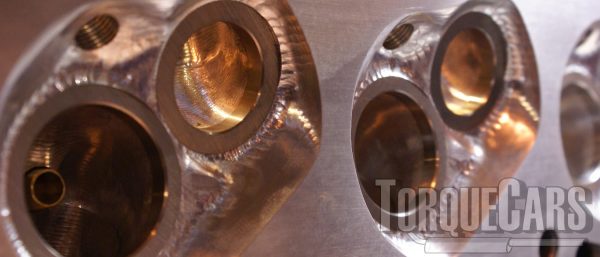
Getting the proper customized components for your car's intended use can save you time and money. The A3 is tough to drive with race spec parts since the Stage 3 motor sport mods weren't designed to work in everyday driving on the road.
Peak power is great, but for a daily driver, you'll need a wider power spectrum and maybe more rev range.
Let's take a closer look at them; in the meanwhile, watch our video on the finest automobile alterations to get the most out of your tuning expenditure.
The best power gains come from larger turbocharged engines. The more you start with the bigger the return on investment so engine swaps are good value mods for small engined cars. You can still tune the smaller non turbo engines but the return is so much lower.
Lets see what modification options you have in your A3 8P tuning project.
Please watch my video which covers the principles of Audi A3 tuning. Be sure to keep up with our latest YouTube content and subscribe.
Best A3 8P Engine Mods & Tuning Upgrades
- Suspension modifications include coilovers and suspension bushing replacement. Coilovers, replacement of old bushings, and attention to the suspension mounts with a strut brace all contribute to enhancing the handling of your A3 8P.
- Upgrades to the brakes - You don't only need to make it move faster; you also need to be able to stop it.
- Mapping the ECU - In terms of cost, turbo upgrades and engine tuning/remapping give the largest benefit on the A3.
- Upgrades to turbochargers – forced induction is the most efficient way to increase air supply, enabling you to burn more gasoline/diesel while producing more power. It is one of the most expensive modifications, but it delivers the most impressive tuning results.
- Lighter flyweels - on most models, the quicker rev speed adjustments will be appreciated in most situations. However, maintain the DMF on diesel engines the vibrations will drive you nuts otherwise.
A3 8P Tuning Stages
Typical stage 1 mods often include: Suspension upgrade (drop 21mm - 39 mm.), Panel air filter, Alloy wheels, Sports exhaust, Engine Tunes/Remapping, Lighter flywheel.
Typical stage 2 mods often include: Power/Sport clutch, Ported and polished head, Fast road cam, high flow fuel injector, fuel pump upgrades.
Typical stage 3 mods often include: Sports gearbox, Internal engine upgrades (pistons/head/valves), Adding or upgrading forced induction (turbo/supercharger), Engine balancing, Competition cam.
A3 8P 2003-2013 engine codes and Specs
| Model | Years | Engine code | Power @rpm | Torque @rpm | ||
| 1.2 TFSI | 2010–2013 | CBZB | 105 PS (77kW; 104hp) @5,000 rpm | 175 Nm (129 lbft) @1,550–4,100 rpm | ||
| 1.4 TFSI | 2007–2013 | CAXC | 125 PS (92kW; 123hp) @5,000 rpm | 200 Nm (148 lbft) @1,500–4,000 rpm | ||
| 1.6 | 2003–2010 | BGU / BSE / BSF / CCS | 102 PS (75kW; 101hp) @5,600 rpm | 148 Nm (109 lbft) @3,800 rpm | ||
| 1.6 FSI | 2003–2007 | BAG / BLF / BLP | 115 PS (85kW; 113hp) @6,000 rpm | 155 Nm (114 lbft) @4,000 rpm | ||
| 1.8 TFSI | 2007–2008 | BYT / BZB | 160 PS (118kW; 158hp) @5,000–6,200 rpm | 250 Nm (184 lbft) @1,500–4,200 rpm | ||
| 2009–2013 | CDAA | 160 PS (118kW; 158hp) @4,500–6,200 rpm | 250 Nm (184 lbft) @1,500–4,500 rpm | |||
| 2.0 FSI | 2003–2008 | AXW / BLR / BLX / BLY BVY / BVX / BVZ |
150 PS (110kW; 148hp) @6,000 rpm | 200 Nm (148 lbft) @3,250–4,250 rpm | ||
| 2.0 TFSI | 2004–2008 | AXX / BPY / BWA / CAWB | 200 PS (147kW; 197hp) @5,100–6,000 rpm | 280 Nm (207 lbft) @1,800–5,000 rpm | ||
| 2009–2013 | CCZA | 200 PS (147kW; 197hp) | 280 Nm (207 lbft) @1,700–5,000 rpm | |||
| 2006–2013 (Audi S3 only) |
BHZ / CDLA | 265 PS (195kW; 261hp) @6,000 rpm | 350 Nm (258 lbft) @2,500–5,000 rpm | |||
| 2.5 TFSI | 2011–2013 (Audi RS 3 only) |
CEPA | 340 PS (250kW; 335hp) @5,400–6,500 rpm | 450 Nm (332 lbft) @1,600–5,300 rpm | ||
| 3.2 | 2003–2009 | BDB / BMJ / BUB | 250 PS (184kW; 247hp) @6,300 rpm | 320 Nm (236 lbft) @2,500–3,000 rpm | ||
| Diesel engines | ||||||
| Model | Years | Engine code | Power @rpm | Torque @rpm | ||
| 1.6 TDI | 2009–2013 | CAYB | 90 PS (66kW; 89hp) @4,200 rpm | 230 Nm (170 lbft) @1500–2500 | ||
| 2009–2013 | CAYC | 105 PS (77kW; 104hp) @4,400 rpm | 250 Nm (184 lbft) @1500–2500 | |||
| 1.9 TDI | 2003–2009 | BJB / BKC / BXE / BLS | 105 PS (77kW; 104hp) @4,000 rpm | 250 Nm (184 lbft) @1,900 rpm | ||
| 2.0 TDI | 2003–2008 | BKD | 140 PS (103kW; 138hp) @4,000 rpm | 320 Nm (236 lbft) @1,750–2,500 rpm | ||
| 2006–2008 | BMM | 140 PS (103kW; 138hp) @4,000 rpm | 320 Nm (236 lbft) @1,750–2,500 rpm | |||
| 2006–2008 | BMN | 170 PS (125kW; 168hp) @4,200 rpm | 350 Nm (258 lbft) @1,750–2,500 rpm | |||
| 2008–2013 | CBAB | 140 PS (103kW; 138hp) @4,200 rpm | 320 Nm (236 lbft) @1,750–2,500 rpm | |||
| 2008–2013 | CBBB | 170 PS (125kW; 168hp) @4,200 rpm | 350 Nm (258 lbft) @1,750–2,500 rpm | |||
| 2010–2013 | CBEA | 140 PS (103kW; 138hp) @4,200 rpm | 320 Nm (236 lbft) @1,750–2,500 rpm | |||
We have the following tuning guides for the Following Audi engines. Some would make great swap candidates for your A3 8P.
- 1.4 1.5 TFSi tuning
- 1.4 TSi/TFSi/Twincharge tuning
- 1.8T engine Tuning
- 1.8 & 2.0 TFSi (mk1) Tuning
- 1.8 2.0 TFSi (ea888) Tuning
- 2.0 TFSi carbon issue & care guide
- 2.5tfsi tuning
- 3.0 V6 24v TFSI Tuning
- 2.8 V6 30 valve, 24 valve 3.0 V6 30v and 3.2 VR6 Tuning
- 3.6 VR6 Tuning
- 1.6 TDi tuning
- 1.9 TDi tuning
- 2.0 TDI 140-170 tuning
- 2.0 TDI tuning (EA188)
- 2.5 TDI tuning
- 2.7 & 3.0 TDI tuning
- 2.5 Tdi R5
- 3.0 Tdi EA897
A3 8P Suspension Modifications
The A3 8P's owners initial point of improvement is generally handling mods. Drop the vehicle as much as 35mm and install stronger dampers; larger drops will almost always need extra changes. The S line suspensions is already around 15mm lower and whilst better than stock it does seem a little crashy and hard.
On the racetrack, quick cornering is crucial, and suspension plays a role. Because the track is forgiving and well maintained, you may employ more severe suspension settings and lower the vehicle more to improve aerodynamics and reduce the centre of gravity.
The rubber suspension bushings of the A3 8P will deteriorate with time, causing squeaks, rattles, and bumps, as well as the suspension not being as tight as it might be.
So fixing the fundamental setup is the first step, and swapping to polyurethane bushings is a terrific suggestion but don't go too hard - Audi chose rubber for a reason as it works well at damping the road vibrations.
So, what variables and considerations must you consider when setting up and selecting the suspension for your everyday driver?
The suspension maintains the tires on the road at the proper angle for optimal contact area. Body roll must be kept at a minimum, and the car's center of gravity must be as low as possible. Torquecars recommends a 35mm drop for most A3 8P models and 20mm for the S Line equipped ones and Quattro.
A3 Suspension Myths and Common Mistakes
Purchasing a non-adjustable suspension setup that lowers the vehicle by 50mm and expecting perfection.
The majority of kits are fairly generic, and vendors often state that they may be used on any or all sorts of vehicles including the diesels and petrol variants. It's a myth that one suspension fits everyone, regardless of engine, wheel, or A3 8P weight (the diesel engines are pretty heavy).
The drive shaft and gearbox may be damaged if the final drive to wheel hub angle is incorrect and taking the weight of the car into account is often overlooked when buying a suspension upgrade kit.
Changing the ride height has an impact on how the suspension travels under load, which may lead to early tyre wear.
Buying some lowering springs and using the OEM specified normal dampers, or upgrading dampers and using standard springs, is likewise a terrible choice. The suspension system as a whole has to be assessed and the whole shock needs to be replaced.
These tolerances may be far lower with standard suspension and 17" rims, however lowering the vehicle may create a slew of troubles.
The objective should always be to enhance handling and lowering the vehicle aids stability by reducing airflow beneath the car.
Make sure your bottom springs and shocks are matching. Cutting the springs is a bad idea since you're asking a piece of metal that was designed to function with a tolerance to do so.
NEVER CUT YOUR A3's SPRINGS! They can shatter or break without notice if they are cut. Indeed to illustrate how brittle some batches were, my S line suspension shattered 3 times on me, the low ride height looked nice but handling was terrible! (If one spring breaks then I suggest you replace them all!)
Ideally, you should get a suspension kit that can be rapidly adjusted to meet your driving style on the vehicle. Coilovers are useful because they may be adjusted to fit your driving style. KW, Koni, Bilstein Eibach, and Bilstein are good makes for the Audi A3 8P.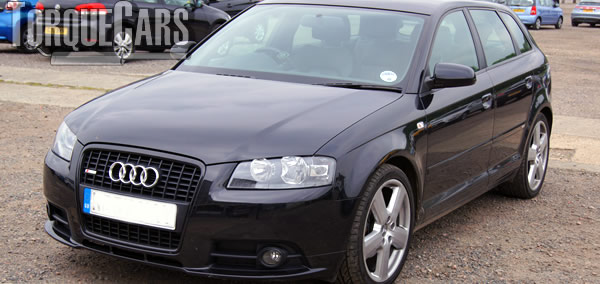
Brake improvement upgrades for the A3 8P
Larger brake discs may spring to mind but don't forget about the pads. They're definitely more influential on your A3's stopping power than the discs, and faulty pads may completely destroy the braking of your A3 8P.
Brakes are essential because going rapidly necessitates the ability to stop quickly. A brake converts kinetic energy into heat by pushing a friction pad on the disc.
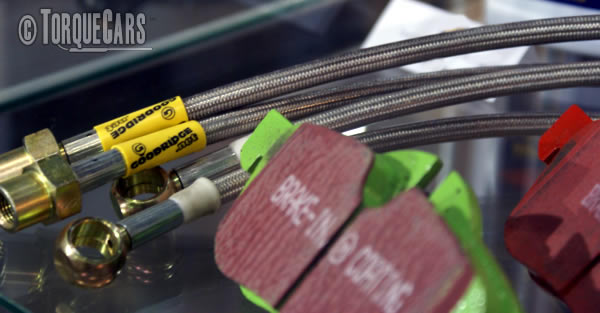
The car's forward motion is slowed when the heat disappears. Brake heat accumulation is visible in nighttime motorsports, as the brakes glow with heat after extensive usage demonstrating how much heat we are dealing with.
When you press the brake pedal, the force is transmitted to a "magic box" called the servo, which utilizes engine power to amplify your foot pressure, giving you a wonderful progressive experience, and this increased pressure is delivered to the friction pads through a brake fluid-filled tube (liquids do not compress like air so efficiently transmit the braking pressure).
The braking fluid itself may grow fairly hot as it approaches the hot brake pad end, placing extra demands on it so spec a decent fluid and braided hoses are a good option too.
Brake fluids are hygroscopic (attract water particles) and may boil at high temperatures; air bubbles in the brake fluid cause a spongy feeling at best and can completely disable the brake at worst, which is why you should replace the fluid on a frequent basis. (For further information on this topic, see the page on Brake Fade.)
A3 Brake Disk Selection
Braking heat is dissipated by the pad over the disks, therefore the colder the disc, the better.
The middle channel on the vented disc increases the surface to air ratio, resulting in better and quicker cooling.
By boosting the air ratio and minimizing gas buildup between the pad and the disc, drilled discs help keep the pads 'clean and sharp.' Larger discs provide greater cooling, although they may need a different alloy wheel.
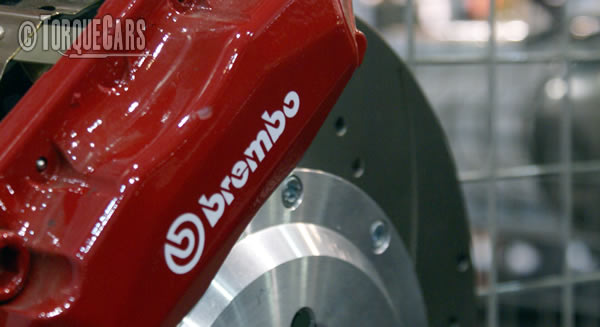
Materials for a pad High-friction brake pads, on the other hand, are required, even if they cause noise and dust.
Racing pads are constructed of a high-friction material that performs best at higher temperatures but at lower temps it can be quite noisy and braking is not very effective at all.
Race grade brake pads are inappropriate for road usage if braking is done on cold pads or in short bursts since they only operate when extremely hot.
There is an excellent balance between braking ability and wear with Pagid and Black Diamond's fast road pads - I've used both on my A3!
Although driving techniques can affect pad and disc wear, certain performance brake pads emit practically no brake dust and last longer than the standard pads I was using. When the ABS senses a lockup, the brake is released until the wheel rotates again.
If you're not a mechanically minded driver, Torquecars recommends leaving brake maintenance to the pros.
Upgrade Mods for your braking system.
The stopping power of an automobile may be enhanced. Normally, the discs and pads would be upgraded. Because a bigger disc has greater friction and disperses more heat, you will see immediate results.
Look to the VW group parts bin for cheap upgrade options. The 1.6 will probably have the 256 or 288mm disc measure them to check this before buying an upgrade. The 2.8 Golf uses 312mm and the R32 334mm both of which make an excellent upgrade path for your A3.
If you have a simple basic spec A3 with tiny discs, you can get brake discs and servos from a performance model in the same family quickly and affordably from your local parts reclaimers and breakers yard. This usually works out much cheaper than an overkill big brake conversion kit.
Because most VAG Group hubs are interchangeable, brakes from VW, Audi, Porsche, Skoda, and Seat are also interchangeable.
Brake Caliper Mods
Calipers (which apply the clamping force) and pistons are the next two items on the list (which push the calipers).
Generally speaking, the more pistons you have, the greater the clamping force, which allows you to use bigger pads.
Large calipers are not a bolt on mod, other things need to be taken into account, it will also usually require different pad sizes and different brake discs.
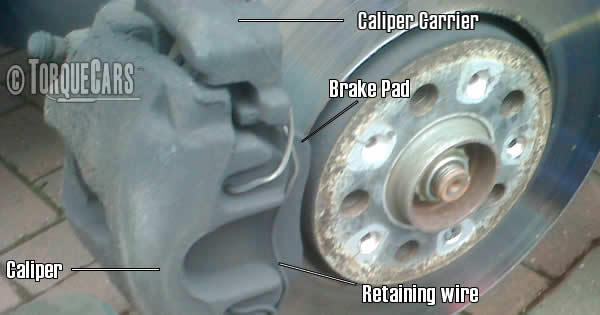
Also the total volume of brake fluid used must match the quantity used in the master cylinder of the donor vehicle. Before the brakes engage, the pedal stroke and feel will be changed, and the pedal will most likely dwell closer to the cars floor reducing your pedal travel if this is not done properly.
The OEM master cylinder may need to be overbored or replaced with a bigger one to match the source vehicle's master cylinder capacity.
Remapping the A3 8P.
What makes OEM maps so bad? A single configuration for everyone generally requires some fiddling with local fuel emission standards and temperatures.
Temperature changes, small flaws, and adverse weather are all included into timing maps. It's not uncommon for nations' CO2, HC, and NOx emission goals to vary.
Manufacturers do not want consumers to be inconvenienced by mechanical or fuel efficiency issues.
Because various nations use different fuel grades and have differing degrees of unfavourable weather, a rule of thumb is required to keep all automobiles working properly internationally.
Each car's output varies by 20bhp depending on component quality and assembly. Instead of customising timing maps for each car, they utilise a one-size-fits-all strategy.
In order to reduce insurance costs and improve fuel efficiency, manufacturers use tunes or remaps to increase engine power.
Plus, the typical TorqueCars reader will be upgrading components, so a tune/remap makes sense and is best done after your other mods.
This includes regular service, dirty plugs and leads, clogged air filters and partly blocked injectors. So on. tune/remap Any engine upgrader should consider remapping.
All current turbocharged engines benefit from remaps, which give 20-30% more power. TorqueCars highly suggests engine tuning/remapping turbocharged automobiles.
What drawbacks are there from engine tuning/remapping your A3?
You should service your automobile more regularly, possibly decreasing the interval. A map optimised for high octane gasoline will need you to repair components that fail due to the added labor. Additional power puts more pressure on components like airflow sensors.
Months after a remap, an engine's weak areas resurface. tune/remap issues, see our instructions.
A tune/remap will usually reveal turbocharger and clutch issues.
Also, turbos may fail, and critical components like pistons and bearings must be maintained. NASP remaps? A tune/remap will only add a few BHP without a turbo (10 percent is typical).
TorqueCars encourages non-turbo cars to modify first (cams, pistons, increase compression, engine balance, air intake, exhaust, head work, bigger valves etc...)
After that, a tune/remap may help you get the most out of them.
Extending your Turbochargers Lifespan
A tune/remap frequently adds boost from lower rpm, making the turbo operate quicker and hotter.
If you don't let the turbo cool, the oil may deteriorate, necessitating a costly turbo repair. Installing a turbo timer will also help cool the engine.
Be wary of peak power claims. Note: Some tuners are known to create a power blip or surge to draw attention and capture headline power statistics.
See the graph below for an example.
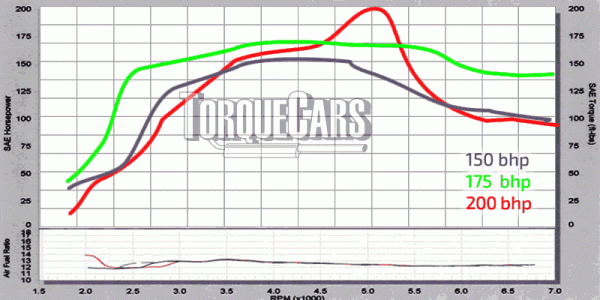
Concentrate on the overall torque curve across the mid to top end of the RPM band instead. At the bottom end, having too much power can end up damaging the turbo and its components, you need a spool down zone in this part of the RPM range.
However, the green trace indicates a steady rise in power across the RPM range, but the red plot shows a decrease.
It also indicates peak power at 4000rpm, which is great for an engine that redlines at 7000rpm.
On a map, we want to see a nice smooth torque climb with no dips or troughs like the green line shown above.
To find out whether the mapper knows his stuff and does a proper tune can be a challenge, but reviews can help.
The other option is to travel to the company's headquarters to see if they just fiddle with the fuel and spark advance tables, never actually seeing the vehicles they are tuning or they are setting this up on a rolling road and producing the most optimized map they can.
Turbo modifications and upgrades for your A3 8P
While larger turbochargers provide greater power, they also wear out the engine and generate more heat. On a petrol engine, a turbocharger may operate between 1100°C and 100,000-150,000rpm.
Some turbo setups and newer models are capable of double these speeds. So lubrication, cooling, and balancing are all required at these speeds. There are three main things that can go wrong with it: oil seal failure, blockage, and bearing wear.
There are two methods to upgrade your turbo.
- A turbocharger hybrid design (based on your OEM casing but with internals from another turbo. )
- A different turbo replacement - Increase the turbo size, which needs new piping and more labor to install.
The first option simply replaces the original, but benefits from remapping, although most hybrid turbos operate very well on standard maps at lower boost levels. Additionally, a hybrid turbo will have better bearings, improved balance, and stronger seals. Reduced revolutions per minute improve reliability but will sacrifice power.
You consider the shape of the air intake aperture, the compressor wheel, and the turbine profile when choosing a turbo upgrade for your A3. Depending on your requirements and where you need the power in your RPM range, they may spin faster, compress more air, or boost at higher or low RPMs. A smaller turbo typically produces a flatter torque curve with less lag.
See our guide to Turbochargers in the Volkswagen and Audi Group (VAG)
There are several turbocharged engine choices available, therefore we'll look at some of the most popular turbos from the VAG group.
Additionally, we examine the turbo's power limitations, which may be surpassed but at the expense of the turbo's lifespan. Generally, before the turbo fails, you will hear a whining or siren sound and then see smoke.
You should now begin searching for a new one. A failed turbo may cause significant damage if the compressor fails and is drawn into the engine.
The following are the distinctions between K03, K03s, and K04:
The K03 turbo was manufactured from 1996 until 2000, when it was superseded by the K03s turbo. But it was fitted to cars either side of these years depending on which model version and country of origin.
The 1.8T AGU engines were equipped with K03 turbochargers. These engines have a mass air flow sensor, a cable-operated throttle, and smaller injectors than standard.
K03s turbos for example are used on AUM engines equipped with MAF and MAP sensors. The improved drive-by-wire throttle on these engines improves both fuel economy and performance. Stigan and BorgWarner are two of the largest manufacturers of K03, K03s, and K04 turbochargers.
Turbos were available in two sizes: K03, K03s, which were both smaller and the K04. While the K04 produces more power, it required a bigger area to install than the K04.
Differences between KO3 and the KO3s
The most major difference between turbos is the number of blades. The K03 has eleven blades, but the K03s has just eight.
While the footprints of the turbos are identical, the actuator that opens the turbine bypass valve varies greatly, often between a 65N and the 85N, while some variations contained a two-port actuator.
Due to the increased boost pressure, 180-horsepower engines often utilize higher-quality actuators with more opening force.
Increased compressor size on the intake side of a hybrid turbo often results in increased power and is a standard strategy used by many manufacturers of hybrids.
The power set in the OEM map for the original K03 is usually the bare minimum, which means it may safely approach 190 horsepower with the appropriate tweaks and upgrades.
The turbo's lifetime, on the other hand, will be reduced the closer you go to the safe limits and the more you push it.
The K03s generates more power than its older sibling, the K03. The safest power output with K03s is roughly 215 bhp; anything more puts the turbo's life in jeopardy. (Individuals have reported extracting up to 250 horsepower from this turbo, so there is some headroom, but anticipate a shorter turbo lifetime.)
K03s provide at least a 25% improvement in power headroom over the K03s, with the possibility for considerably more if you are prepared to sacrifice turbo life or do more thorough maintenance.
Comparison to K03(S), vs the K04
The K04 provides a Significant Advantage. In comparison to the K03 and K03s, the K04 is much larger and produces far more power at the top end with a little more lag at the bottom but not much.
The K04's performance may be boosted to max around 350 bhp with the appropriate hardware, but the KO4's safe limit is 220 bhp.
A3 Diesel Turbo Upgrades.
The superb BORGWARNER BV40 VNT was used on the 2.0 TDi upto 2003 (approx) and hybrid upgrades are many and plentiful. The later 2010 2.o TDI140 and 170hp's used different turbos to the Borgwarner BV43 so dropping in the newer (Garrett GTC14V) 170 turbo will give you some headroom in your diesel A3 Tuning project.
See our 2.0 TDi article for more details on the turbo diesel engine upgrades.
How To Choose The Best Turbo Upgrades
There are sadly many counterfeit and low-quality turbo units available, so it's critical to thoroughly investigate your source to determine which are reputable suppliers.
We promise that if you install a cheap turbo upgrade rather than a quality turbocharger in the first place, you will have to do the task all over again in six months.
When it comes to A3 Turbo features, look for a turbocharger that has the following:
- A billet aluminum compressor wheel (light and strong)
- Flow Optimized Vanes (Maximizes the boost available)
- A performance wastegate actuator (sharpens throttle response and maximizes your power gains)
The smallest thing might be the difference between a successful project and a money pit. Remapping IS A REQUIREMENT after a turbo upgrade.
Frequently, replacing the original turbo with a more powerful aftermarket turbo requires changing the vehicle's mapping. If this is not done, the engine may run lean or enter limp home mode, resulting in error codes.
Turbochargers Replacements
When the time comes to replace the factory turbocharger, the following alternatives are available: Alternatives to K03.
To enhance the basic K03 performance, the following are some choices to consider; however, bear in mind that inline and transverse mounted engines have distinct turbo designs, so do not mix them up:
- 847-1001 with item number 40-30002 (SG stands for Stigan). This turbocharger is a direct fit for a broad variety of vehicles.
1.8-liter Audi A4 models from 1997 to 2006, 1.8-liter Volkswagen A3 8P models from 1998 to 2004, and 1.8-liter Volkswagen A3 8P models from 2005.
- 53039880029 BorgWarner sells this item under the SKU 40-30002 BW.
Among the vehicles equipped with this turbocharger are the following: From 1997 until 2006, Audi A4 1.8 liters From 1998 to 2004, Audi A3 8P 1.8 liters A 1.8-liter gasoline engine powers the 2005 Audi A3 8P.
Replacing a K04
Consider the following options when replacing the original K04 turbo: 847-1435 with SKU 40-30002 SH a Stigan product. The following vehicles may be a suitable fit for this Stigan High-Performance New Turbocharger:
From 1997 through 2006, an Audi A4 1.8 liter Turbo variant was available with this turbo. From 1998 to 2004, the A3 1.8 T in most areas used the BorgWarner item SKU 40-30003 AW (53049500001).
Despite the fact that newer and better turbos are being introduced to autos on a regular basis, changing a turbo is not as simple as one may believe. Changing the turbocharger on a VAG group vehicle to a different model needs the following steps:
- Replacing worn-out fuel injectors
- Changing the diameter of the exhaust pipe
- A new fuel pump may need to be fitted.
- Substituting a performance boost controller
- Remapping (not essential in some cases but you'll miss most of the benefits)
- Improving the intake cooling equipment (intercoolers)
- The wastegate needs replacement.
- Utilization of less restrictive catalytic converters
- Removing and replacing restrictive exhaust mufflers
- Intakes may also need replacing if there is a restriction
The engine compartment's design and your base engine also plays a significant role in determining how difficult it will be to swap an Audi turbo to another vehicle. The transverse and Longitudinal engines' turbos are different.
Exhaust and intake pipes may need to be relocated, the intercooler may need to be enlarged, and space constraints may apply.
Turbo Power Constraints & Limits
Turbo limits - safe should retain factory reliability and longevity, the Max however is pushing to the limits and will certainly shorten the lifespan of the turbo.
| Turbo | Safe Max | Maximum |
| K03 | 190hp | 220hp |
| K03s | 215hp | 250hp |
| K04 | 220hp | 350hp |
With a few minor adjustments with a Stage 1 remap, you should expect your A3's K03s turbo to produce between 210 and 220 horsepower (Air filter, exhaust, bolt-on modifications).
However, depending on the changes, Stage 2 Remapping (catalytic converter replacements, fuelling refinements, and intercooler upgrades) may deliver between 230 and 250 horsepower.
Bear in mind that Stage 2 engine tuning/remapping requires an intercooler to reduce the air temperature; otherwise, you will be restricted to lesser power output.
K04 remapping
Stage 1 modifications to the K04 turbo increase its maximum power output by approximately 220 to 350 horsepower, but we've seen several improvements to the FMIC (Front Mount Intercooler) needed to get this power level. Also use a high octane fuel to achieve such a high level of performance (your OEM clutch will also typically start to slip).
We are assuming a 1400kgs kerb weight, & Manual transmission for the performance tuning figures in the table below
| Base power | Quarter Mile |
Tuned to |
Kerb Weight |
Quarter Mile |
| 115hp | 18.27 | 120hp | 1400kg | 18.02 |
| 150hp | 16.77 | 170hp | 1400kg | 16.1 |
| 185hp | 15.67 | 225hp | 1400kg | 14.71 |
| 640hp | 1400kg | 10.98 | ||
| 550hp | 1200kg | 10.97 |
Anything over 225hp will require all wheel drive or rear wheel drive due to traction issues, even with a clever setup and differential you'll be hard pressed to get that power down on a FWD A3. RWD conversions are possible but quite a challenge to pull off, it would be easier to drop in the quattro drivetrain.
A3 Lighter Flywheels
The flywheel makes the car more resistant to changes in engine speed, which is good for cruising but bad when you need a rapid response from the A3's engine. They also lessen the likelihood of a reversal in four-cylinder engines.
A lighter wheel reduces the strain on the engine and enables it to rev more freely, resulting in increased power. The rpm of a race-tuned engine are substantially quicker than those of a stock engine. Engine momentum or inertial spin is reduced with a lighter flywheel, which is apparent on slopes and hills where the car will bog down.
For optimal torque delivery and free revving, several flywheel weights are available allowing you to fine tune the benefits. You don't want to go too light in a street car since it will affect your tick over. Discuss your application with other TorqueCars users in our car forums.
You should replace the A3 flywheel as well as changing the clutch otherwise you'll be paying to remove the gearbox for each job.
Some models came with a dual mass flywheel where a spring connects two separate flywheel surfaces. Rotational acceleration and deceleration are both dampened by the spring which really helps in the diesel engines.
Some of our members are replacing DMFs with solid, lighter flywheels, however we suggest that you first read our DMF to SMF conversion article first.
Audi A3 8P Intake & Exhaust.
We'll now study the intake and exhaust systems to ensure optimal engine flow. A complete induction package delivers the most power improvements. We recommend using a panel air filter instead on tiny engines since you will lose low-down power.
Increasing the valve size in the A3 8P engine heads, as well as doing port work and head flowing, will enhance torque and, more crucially, allow you to boost torque on other tuning items.
Opening up the air intake port to match the intake manifold would not help much unless there is a step obstructing airflow into the engine. As a consequence, the exhaust ports are the optimum places to undertake DIY port matching but we'd still recommend you get professional help with this.
Extending the port size isn't always beneficial, and it's only necessary for highly tuned engines when the port size has become a bottleneck.
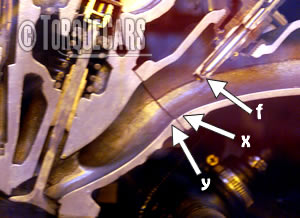
Using slightly narrower channels with fewer bends or angles may enhance flow rates significantly.
This will limit power; the objective should be to have both port openings at approximately the same size to eliminate turbulence on the downflow side; this is why many current intakes are now constructed of molded plastic, which is lightweight and can be shaped to a very exact form.
The objective of making a seamless connection between both the intake manifold (x) as well as the engine port (y) in a highly tuned rally vehicle engine is shown in this illustration.
The fuel injector (f) sprays fuel into the intake manifold and has a direct route to the valves (a direct injection engine clearly does not).
The intake angle has also been lowered, allowing the air to flow virtually straight down into the engine. This is not always achievable on all engines, but the goal is to smooth the air flow and reduce bends.
Don't aim for the largest exhaust you can get; 1.5 to 2.5 inches is generally the sweet spot for power improvements.

Uprated injectors will enable you to supply sufficient fuel to the engine. Making more power requires more fuel and this usually means the OEM injectors will need an upgrade.
Uprate the fuel pump to cope with the extra fuel requirements of your tuned A3 8P's uprated injectors.
Audi A3 8P Wheel Modifications.
Alloy wheels will aid in the cooling of the brakes and are often lighter than steel wheels. It's worth mentioning that, although big alloy wheels look good on the A3 8P, they actually reduce performance.
Due to the difference in your effective final drive ratio, the bigger you go, the lower your peak speed will be. Keep the wheel's overall rolling diameter the same as it came from the manufacturer.
We don't advocate going exceeding 18 inches in any situation. Some of our members have installed 19- and 20-inch wheels, mostly to accommodate a Porsche brake upgrade, however they have all suffered tram lining and other difficulties as a result of the higher rim size. Alloy wheels will aid in the cooling of the brakes and are often lighter than steel wheels. It's worth mentioning that, although they look great on the A3 8P, they're not for everyone. Your performance will be harmed by large alloy wheels.
Due to the difference in your effective final drive ratio, the bigger you go, the lower your peak speed will be. Keep the wheel's overall rolling diameter the same as it came from the manufacturer.
We don't advocate going above 18 inches in any scenario. Some of our members have installed 19- and 20-inch wheels, mostly to accommodate a Porsche brake upgrade, however, they have all suffered tram lining and other difficulties as a result of the higher rim size.
A3 9P Common Problems
There are a few problems and issues to look out for on popular vag group engines, but I've split these off into other articles.
- 2.0 TFSi carbon buildup issues - direct injection engines require an intake clean.
- 2.0 TFSi problems - N75 and N249, high oil consumption, Cam Follower wear, Water Pump failure, and Turbo issues
- 2.0 TDi problems - Flywheel, Oil pump, Lumpy Idling
- 1.8T Problems - Diagnosing the common faults and issues
Please join us in our forum to discuss the A3 8P options in more detail with our A3 8P owners. It would also be worth reading our A3 8P tuning articles to get a full grasp of the pros and cons of each type of modification.
Please Check out my YouTube channel, we're regularly adding new content...
PLEASE HELP: I NEED YOUR DONATIONS TO COVER THE COSTS OF RUNNING THIS SITE AND KEEP IT RUNNING. I do not charge you to access this website and it saves most TorqueCars readers $100's each year - but we are NON PROFIT and not even covering our costs. To keep us running PLEASE Donate here
If you liked this page please share it with your friends, drop a link to it in your favourite forum or use the bookmarking options to save it to your social media profile.
Feedback - What do You Think?
Please use our forums if you wish to ask a tuning question, and please note we do not sell parts or services, we are just an online magazine.
Help us improve, leave a suggestion or tip
Please watch this video and subscribe to my YouTube channel.

 Click to accept YouTube Cookies & Play.
Click to accept YouTube Cookies & Play.